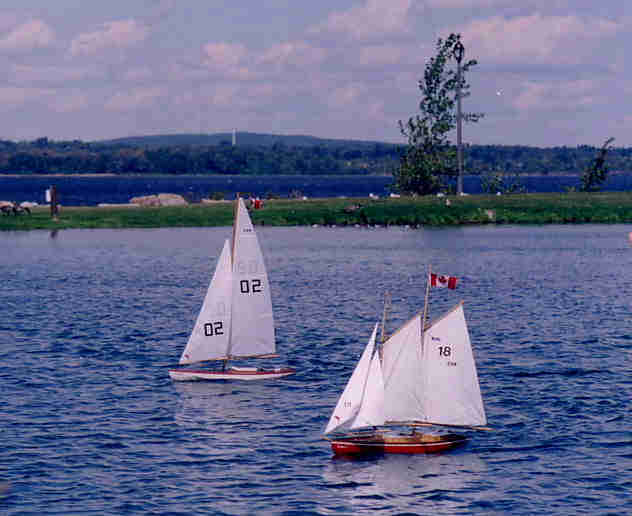Mini 12 Metre Class
The Mini 12 is the latest class of R/C yacht to be added to the C R Y A class
registry.
The hulls are manufactured by Mr. Frank Scott of Newington, Ontario.
Frank is a professional big boat builder and has had a long time interest in
model sailboats. At this time the Mini 12 has a growing fleet in the
eastern part of Ontario. With a length of 45 inches and a weight of about 15
pounds the Mini 12 has proven itself adept at conquering weeds which are a
problem at a number of sailing sites.

Photo by Jim Horne
Mini 12 sail 02 in its standard configuration. Sail 18 demonstrates the
versatility of the design in this schooner rig.
Mini 12 Metre Canadian Class Secretary
Requests for more information on the class in general or on class activities
in Canada may be directed to the class
secretary Bernie Reid.
Mini 12 Class Rules
1. CONCEPT
Restrictions listed are intended to maintain a one-design
class; a fiberglass hull from master molds.
2 STANDARD
Mini 12 boats must be built to these rules and drawings.
3.DECK AND HATCHES
Deck and hatches made of wood or ABS plastic 9" maximum.
4. BALLAST
Ballast shall consist of lead shot No.9 or 10, 11 lbs. to 11.5
lbs bonded in the keel. Minimum total sailing weight 16 pounds.
5. RUDDER
Rudder shall conform to the drawing made of plywood and brass
bar.
6. SPARS
Mast and booms shall be made of wood.. No aluminum, carbon
fiber, Kevlar. or hollow wooden shall be allowed. Slotted wooden masts are
allowed. Jib boom shall not extend beyond the bow.
7. RIGGING
The use of commercially available or home made fittings,
goosenecks, screw eyes, Fairleads, bowsies, etc. and woven or braided wire for
shrouds shall be permitted.
8. MAST RIGGING
Multiple diamond rigging shall not be allowed.
9. MAST CRANE - BACKSTAY FITTING
The crane on top of mast shall be no more than 3.5" long.
The backstay fitting must not go beyond transom.
10.MAINSAIL HEIGHT
The maximum height of the mainsail from the deck shall not
exceed 51 3/8".
11. JIB STAY ATTACHMENT
The height from deck to jib stay attachment on the mast shall
not exceed 44 7/8", including the jack screw, if used.
12. DECK LAYOUT
All positions of deck fittings must conform to the control
drawing.
13. SAILS
Sails are cut to match the sail control drawing. Paneled sails
are not allowed.
14. SAIL MATERIAL
Sail material to be Dacron, nylon, or Mylar only.
15. BATTENS
Mainsail: No more than 3 battens positioned in such a way that
the leach is divided into 4 equal parts. Maximum batten lengths: top -5",
middle -6", bottom 4".
Jib Sail: NO more than 2 battens positioned in such away that the leach is
divided into 3 equal parts. Maximum batten lengths: top 4", bottom
2.5"
16 SAIL REINFORCEMENT
The sails may be reinforced by addition of woven cloth or tape
material within 2 inches of head, tack, and clew corners. and within 1/4"
of the leech edge.
17. SAIL NUMBERS AND CLASS LOGO
Sail numbers are shown on the control drawing. The sail
numbers are inside the hull on the starboard side.
18. RADIO
A maximum of two channels shall be allowed. One channel used
for sail control and one channel shall be used for rudder control The use of a
backstay tensioner, and extra jib trimmer, jib twitchers, etc. is prohibited
19. WIND INDICATORS
The use of a wind indicator or flag on top of the mast shall
be permitted.
20. SHEET LEAD
Sheet leads are the maximum of 1/2" off the top of the
deck.
| ![[Company Logo Image]](_borders/cryalogo.jpg) Canadian Radio Yachting Association
Canadian Radio Yachting Association